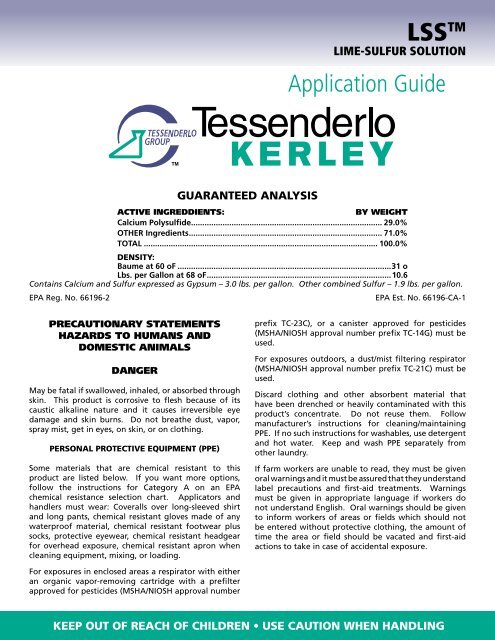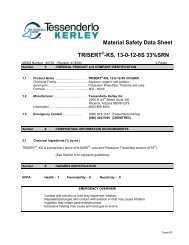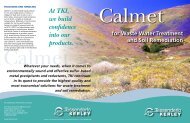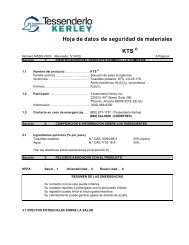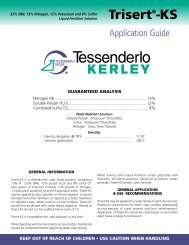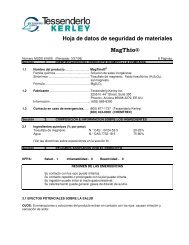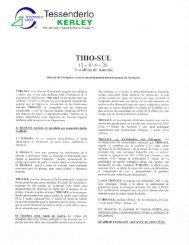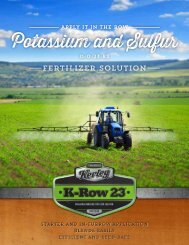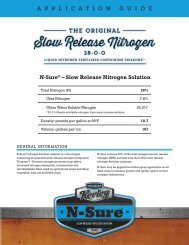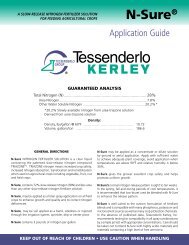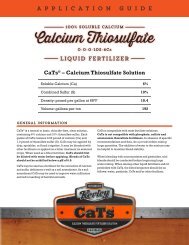Create successful ePaper yourself
Turn your PDF publications into a flip-book with our unique Google optimized e-Paper software.
<strong>LSS</strong> TMLIME-SULFUR SOLUTION<strong>Ap</strong>plication <strong>Guide</strong>GUARANTEED ANALYSISACTIVE INGREDDIENTS:BY WEIGHTCalcium Polysulfide..................................................................................... 29.0%OTHER Ingredients...................................................................................... 71.0%TOTAL......................................................................................................... 100.0%DENSITY:Baume at 60 oF................................................................................................31 oLbs. per Gallon at 68 oF..................................................................................10.6Contains Calcium and Sulfur expressed as Gypsum – 3.0 lbs. per gallon. Other combined Sulfur – 1.9 lbs. per gallon.EPA Reg. No. 66196-2EPA Est. No. 66196-CA-1PRECAUTIONARY STATEMENTSHAZARDS TO HUMANS ANDDOMESTIC ANIMALSDANGERMay be fatal if swallowed, inhaled, or absorbed throughskin. This product is corrosive to flesh because of itscaustic alkaline nature and it causes irreversible eyedamage and skin burns. Do not breathe dust, vapor,spray mist, get in eyes, on skin, or on clothing.PERSONAL PROTECTIVE EQUIPMENT (PPE)Some materials that are chemical resistant to thisproduct are listed below. If you want more options,follow the instructions for Category A on an EPAchemical resistance selection chart. <strong>Ap</strong>plicators andhandlers must wear: Coveralls over long-sleeved shirtand long pants, chemical resistant gloves made of anywaterproof material, chemical resistant footwear plussocks, protective eyewear, chemical resistant headgearfor overhead exposure, chemical resistant apron whencleaning equipment, mixing, or loading.prefix TC-23C), or a canister approved for pesticides(MSHA/NIOSH approval number prefix TC-14G) must beused.For exposures outdoors, a dust/mist filtering respirator(MSHA/NIOSH approval number prefix TC-21C) must beused.Discard clothing and other absorbent material thathave been drenched or heavily contaminated with thisproduct’s concentrate. Do not reuse them. Followmanufacturer’s instructions for cleaning/maintainingPPE. If no such instructions for washables, use detergentand hot water. Keep and wash PPE separately fromother laundry.If farm workers are unable to read, they must be givenoral warnings and it must be assured that they understandlabel precautions and first-aid treatments. Warningsmust be given in appropriate language if workers donot understand English. Oral warnings should be givento inform workers of areas or fields which should notbe entered without protective clothing, the amount oftime the area or field should be vacated and first-aidactions to take in case of accidental exposure.For exposures in enclosed areas a respirator with eitheran organic vapor-removing cartridge with a prefilterapproved for pesticides (MSHA/NIOSH approval numberKEEP OUT OF REACH OF CHILDREN • USE CAUTION When HANDLING
USER SAFETY RECOMMENDATIONSUsers should: Wash hands before eating, drinking,chewing gum, using tobacco, or using the toilet. Removeclothing immediately if pesticide gets inside. Thenwash thoroughly and put on clean clothing. RemovePPE immediately after handling this product. Wash theoutside of gloves before removing. As soon as possible,wash thoroughly and change into clean clothing.ENVIRONMENTAL HAZARDSDo not apply directly to water, to areas where surfacewater is present, or to intertidal areas below the meanhigh water mark. Do not contaminate water whendisposing of equipment wash waters.PHYSICAL OR CHEMICAL HAZARDSMAY GIVE OFF HIGHLY TOXIC AND EXTREMELYFLAMMABLE HYDROGEN SULFIDE GAS IF MIXEDWITH ACIDSDIRECTIONS FOR USEIt is a violation of Federal Law to use this product in amanner inconsistent with its labeling.Do not apply this product in a way that will contactworkers or other persons, either directly or throughdrift. Only protected handlers may be in the area duringapplication. For any requirements specific to your Stateor Tribe, consult the agency responsible for pesticideregulation.AGRICULTURAL USE REQUIREMENTSUse this product only in accordance with its labeling andwith the Worker Protection Standard, 40 CFR part 170.This standard contains requirements for the protectionof agricultural workers on farms, forests, nurseries, andgreenhouses, and handlers of agricultural pesticides. Itcontains requirements for training, decontamination,notification, and emergency assistance. It also containsspecific instructions and exceptions pertaining to thestatements on this label about personal protectiveequipment, and restricted-entry interval. Therequirements in this box only apply to uses of this productthat are covered by the Worker Protection Standard.Do not enter or allow worker entry into treated areasduring the restricted entry interval (REI) of 48 hours.permitted under the Worker Protection Standard andthat involves contact with anything that has beentreated, such as plants, soil, or water, is: Coveralls overlong-sleeved shirt and long pants, chemical resistantgloves made of any waterproof material, chemicalresistant footwear plus socks, protective eyewear, andchemical resistant headgear for overhead exposure.NON-AGRICULTURAL USE REQUIREMENTSThe requirements in this box apply to uses of thisproduct that are NOT within the scope of the WorkerProtection Standard for agricultural pesticides (40 CFRpart 170). The WPS applies when this product is used toproduce agricultural plants on farms, forests, nurseries,or greenhouses.For spray applications do not enter treated areas withoutprotective clothing until sprays have dried.GENERAL INSTRUCTIONS FOR USESome fruits and other plants are susceptible to injuryfrom sulfur under certain climatic conditions. The useris advised not to use sulfur on any crop unless local usehas proved that sulfur does not damage crops in thatlocality.USE PRECAUTIONS: Do not use this product within 30days of an oil spray at any stage other than dormant(deciduous only) unless prior experience in yourimmediate area has shown that shorter intervals will notresult in phytotoxic injury. Lime-Sulfur may burn foliagewhen temperature is high; avoid applying this materialduring very hot periods of the day (above 85oF). Keepcontainer tightly closed when not in use. If crust shouldform on the surface, break through the crust so productwill pour.Do not apply, or allow to drift, to painted surfaces, asa permanent stain may result. Do not combine Lime-Sulfur with other pesticides unless previous experiencehas shown them to be compatible. If tank mixing,always follow the more restrictive label directions. Thisproduct cannot be mixed with any product containing alabel prohibition against such mixing. Read entire labeland use strictly in accordance with label directions.Do not apply this product through any type of irrigationsystem.Do not use this product for crop thinning.PPE required for early entry to treated areas that is
Unless otherwise indicated, the following use rates areper 100 gallons of water. Where a rate range is given,use the higher rates when disease is severe or wheredisease was severe in the previous season.Since <strong>Tessenderlo</strong> <strong>Kerley</strong>, Inc. cannot make thedetermination of the tree density and row spacing in anygiven orchard, in order to prevent potential crop injury,the responsibility of using the proper spray equipment,correct calibration for the sprayer, correct label rateand uniform distribution of the spray pattern are theresponsibility of the grower/applicator.DILUTE – For general dilute applications, use highergallonage (100 – 400 gal/acre) on larger trees whererequired.CONCENTRATE – For concentrate spray applications,use 100 gal/acre. NOTE: When using concentrate spraysdo not exceed 12 gallons of Lime-Sulfur Solution per 100gallons on a per acre basis.(NOTE: Rust mites and scale insects have been shown tobe more effectively controlled with dilute or semi-diluteapplications.)ALMONDS: DORMANT for Powdery Mildew, Shothole– <strong>Ap</strong>ply 1 to 3 applications of 8 gallons at two weekintervals between November 15 and December 15.DORMANT OR DELAYED DORMANT for Scab(Cladosporium carpophilum) apply 8 – 16 gallons in 100gallons per acre in a concentrate spray per acre. As adilute spray apply 4 gallons.PRE-BLOOM, EARLY BLOOM and FULL BLOOM forBrown Rot Blossom Blight – <strong>Ap</strong>ply ¾ to 1½ gallons.APPLES: DORMANT for Blister Mite, Rust Mite, BrownMite, European Red Mite and San Jose Scale – <strong>Ap</strong>ply 6to 11 gallons, OR 3 gallons plus 1½ gallons supreme orsuperior type oil spray. For Blister Mite and Rust Miteonly – <strong>Ap</strong>ply 3 gallons.NOTE: <strong>Ap</strong>ple Scab and Powdery Mildew are notcontrolled at this stage.DELAYED DORMANT for Blister Mite, Rust Mite, <strong>Ap</strong>pleScab, Brown Mite, Powdery Mildew – <strong>Ap</strong>ply 3 gallons.For Leaf Spot – Increase rate to 7½ to 10 gallons. (SeeGrowing Season Recommendation). For Scab only –<strong>Ap</strong>ply 1½ to 2 gallons, repeat in Pre-Pink and Pinkstages.PRE-PINK for Powdery Mildew, <strong>Ap</strong>ple Scab – <strong>Ap</strong>ply 2to 3 gallons. For <strong>Ap</strong>ple Scab repeat in Pink stage. ForPowdery Mildew see Pink stage recommendation.PINK for Powdery Mildew, <strong>Ap</strong>ple Scab – <strong>Ap</strong>ply 2½gallons or 2 gallons plus 5 pounds of wettable sulfur.A Petal Fall application may be needed.PRE-BLOOM for Blotch – <strong>Ap</strong>ply 2 gallons, repeat atPetal Fall, and again 10 days later.PETAL FALL for Blotch – (See Pre-Bloomrecommendation) – <strong>Ap</strong>ply 2 gallons. Repeat in 10days.GROWING SEASON FOLIAR SPRAYS for LeafSpot – <strong>Ap</strong>ply ½ gallon (See Delayed Dormantrecommendation).NOTE: Use on Delicious apples may cause injury.NOTE: DO NOT USE ON GINGER GOLD APPLES.POST-HARVEST (Late fall after temperatures cool (Mid-October to November) before the first frost): For RustMite, Blister Mite, San Jose Scale, <strong>Ap</strong>hid and Mite eggs– <strong>Ap</strong>ply 3 to 5 gallons plus 1½ to 2 gallons of supremeor superior type oil.NOTICE TO USER: Post-Harvest applications of LimeSulfur may cause early defoliation. Early Post-Harvestsprays (early to mid September) can retard tree growthand are not recommended.BLUEBERRIES: Phomopsis Cane and Twig Blight – <strong>Ap</strong>ply5 to 6 gallons per 100 to 150 gallons of diluted spray peracre. <strong>Ap</strong>ply during delayed dormant stage after leafbuds begin to break. To aid control of Mummy Berry(caused by the fungus Monilinia vaccinii-corymbosi),apply a post harvest (September to October) or earlydormant spray of 8 gallons Lime-Sulfur Solution per100 gallons of water. Use 200 to 300 gallons of sprayper acre.NOTE TO USER: Do not use within 14 days of anoil spray or when temperatures are above 85oF.Burning of foliage may occur during period of warmtemperatures.CANEBERRIES: (Such as Blackberries, Boysenberries,Raspberries, and other caneberries.)FALL application for Red Berry Mite, Blackberry LeafMite – <strong>Ap</strong>ply 8 gallons after old canes have beenremoved from the field.DORMANT OR DELAYED DORMANT (Green Bud)for Anthracnose, Cane Blight, Powdery Mildew,Overwintering Spores, Rust – <strong>Ap</strong>ply 6 to 12 gallons.For Spur Blight – <strong>Ap</strong>ply one spray at 12 gallons or twosprays at 10 gallons before buds break and show silver.For Overwintering Spores only – <strong>Ap</strong>ply 2 1/3 gallons.
DELAYED DORMANT or when leaf buds first startto open for Red Berry (Blackberry mite), Rose Scale,Oyster Scale, San Jose Scale, and Yellow Rust – <strong>Ap</strong>ply 8gallons.EARLY SPRING when new growth is 1½ inches long,use 5 gallons for the control of Rose Scale, OysterScale, San Jose Scale, and Yellow Rust. When fruitingcanes are 8 to 12 inches long and before blossomshave opened – for Anthracnose, Cane Blight, PowderyMildew and Rust – <strong>Ap</strong>ply 8 1/3 gallons. Do not use onraspberries at this timing.CHERRIES (SWEET): DELAYED DORMANT for PowderyMildew – <strong>Ap</strong>ply 7½ gallons. For the control of CoryneumBlight, Scale Insects, Peach Twig Borer, Leaf Curl, SilverMites – <strong>Ap</strong>ply 6 to 11 gallons per 100 gallons of sprayor at a rate of 3 gallons with 1½ gallons of superiortype oil per 100 gallons for additional control of BrownMites and Red Mites.POST-HARVEST for Brown Mites, Two Spotted Mite –<strong>Ap</strong>ply 1 gallon plus 4 pounds wettable sulfur.POST-HARVEST for Powdery Mildew – <strong>Ap</strong>ply 10 to 20gallons per acre in sufficient water for coverage.CHERRIES (TART): DELAYED DORMANT for thecontrol of Coryneum Blight, Scale Insects, Peach TwigBorer, Leaf Curl, Silver Mites – <strong>Ap</strong>ply 6 to 11 gallonsper 100 gallons of spray or at a rate of 3 gallons with1½ gallons of superior type oil per 100 gallons foradditional control of Brown Mites and Red Mites.PRE-BLOOM, EARLY BLOOM and FULL BLOOM forBrown Rot Blossom Blight, Leaf Spot, Scab – <strong>Ap</strong>ply upto 3 sprays at 1½ gallons.LATE SEASON for Brown Rot (Fruit), Leaf Spot,Powdery Mildew – Use ½ gallon. <strong>Ap</strong>ply 3 to 5 sprays atweekly intervals until harvest.POST-HARVEST for Brown Mites, Two Spotted Mite –<strong>Ap</strong>ply 1 gallon plus 4 pounds wettable sulfur.CITRUS: Red Spider Mites – <strong>Ap</strong>ply 2 gallons when themites appear. Thrips – <strong>Ap</strong>ply 2 gallons. <strong>Ap</strong>ply asrecommended by your State Agricultural ExperimentStation.Rust Mites – JANUARY apply 1½ gallons. APRIL orMAY, AUGUST 15 to SEPTEMBER 15 and OCTOBER 15to DECEMBER 15 – <strong>Ap</strong>ply 7½ pints per 100 gallons.Tangerines should be sprayed during late winter andearly spring (February 15 to <strong>Ap</strong>ril 15).NOTE: Early and Mid-Season citrus may be injuredby Lime-Sulfur sprays during summer and early fallmonths.ORANGES (NAVEL and VALENCIA) for Flat Mite,Thrips, light infestations of Citrocola Scale – <strong>Ap</strong>ply 2gallons in winter between January 1 and March 15, butbefore new shoots exceed ½ inch in length. Do notapply where heavy copper residues are present.HAZELNUTS – Big Bud Mite – (Not for use in California)– <strong>Ap</strong>ply 12 gallons of product per acre in sufficientwater for complete coverage of trees (recommenda minimum of 100 gallons of water per acre). <strong>Ap</strong>plywhen buds begin to open in the spring.CURRANTS, GOOSEBERRIES: BUD BREAK forAnthracnose – <strong>Ap</strong>ply 2½ gallons. Repeat 10 to 15 dayslater. <strong>Ap</strong>ply 3 pints at 10 day intervals after secondspray if needed.PRE-BLOOM and POST-BLOOM for Powdery Mildew –<strong>Ap</strong>ply 1½ quarts.FRUIT TREES (BEARING): DORMANT for OverwinteringSpores – <strong>Ap</strong>ply 3½ gallons. Do not apply to apricots.FRUIT TREES (NON-BEARING): CLUSTER BUD andPRE-BLOOM for Blotch, Powdery Mildew, Scab – <strong>Ap</strong>ply2½ quarts. Do not apply to apricots.GRAPES: DORMANT for Phomopsis – Prior to bud swell,apply 15 – 20 gallons per acre in sufficient water forcoverage. Spray to runoff.During the DORMANT period for Powdery Mildew,Mealybugs – <strong>Ap</strong>ply 4 to 10 gallons per acre in sufficientwater for coverage.During the growing season when new shoots are 4to 6 inches long for Anthracnose, Powdery Mildew,Mealybugs – <strong>Ap</strong>ply 2 quarts in sufficient water forcoverage. On mature foliage use 1 pint plus 4 poundsof wettable sulfur.For later applications during the growing season forPowdery Mildew eradication – <strong>Ap</strong>ply 2 to 4 quartsplus 1 to 4 pounds wettable sulfur, plus ½ pint SulforixFoliage Spray per 100 gallons. <strong>Ap</strong>ply 300 gallons ofspray mix per acre for thorough coverage. DO NOTapply after 5:00 a.m. or during the day when maximumtemperatures are expected to exceed 85oF or sulfurburn may occur.
NECTARINES: EARLY WINTER and LATE DORMANTfor Leaf Curl – <strong>Ap</strong>ply 6 gallons.GROWING SEASON for Powdery Mildew – <strong>Ap</strong>ply 2 to3 quarts when disease appears. For Brown Rot, LeafSpot, Shothole – Use 2 quarts. <strong>Ap</strong>ply 3 to 5 times atweekly intervals until harvest.PEACHES: DORMANT for Peach Leaf Curl, Scab,Shothole – <strong>Ap</strong>ply 10 to 12 gallons. For Leaf Curl only– <strong>Ap</strong>ply 6 to 8 gallons in full coverage spray. <strong>Ap</strong>plyafter all leaves have fallen and before buds begin toswell. If Leaf Curl has been severe, two applicationsmay be needed, the first in Early Dormant, the secondin Delayed Dormant.DORMANT OR DELAYED DORMANT for Scale Insects,Silver Mites, Peach Twig Borers, Coryneum Blight,<strong>Ap</strong>hids – <strong>Ap</strong>ply 6 to 11 gallons per 100 gallons sprayor 3 gallons per 100 gallons with 1½ gallons superiortype oil for additional control of Brown Mites and RedMites.DELAYED DORMANT for Powdery Mildew – <strong>Ap</strong>ply7½ gallons at Green Tip, apply second spray at 4 to 5gallons.DO NOT apply dormant spray to peaches immediatelyafter or during periods of 5 days or more of unseasonablyhigh temperatures if a sufficient number of dormantcold hours have occurred.PRE-BLOOM, EARLY BLOOM and FULL BLOOM forBrown Rot Blossom Blight – <strong>Ap</strong>ply ¾ to 1½ gallons, onespray at each period of conditions require it.SUMMER FOLIAGE SPRAYS for Powdery Mildew –<strong>Ap</strong>ply 1½ quarts. For Brown Rot, Powdery Mildew,Leaf Spot – <strong>Ap</strong>ply ½ to 1 gallon 3 to 5 times at weeklyintervals until harvest. Avoid spraying during hotperiod of the day or during hot humid conditions.Spray only to the drip point, not to runoff, as excessivespray may cause injury.PEARS: DORMANT for Pear Leaf Blister Mite – <strong>Ap</strong>ply 5to 7 gallons. May be combined with oils labeled fordormant use on pears.DORMANT OR DELAYED DORMANT to prevent PearScab infections and to aid in the control of hatchingeggs and young nymphs of Green <strong>Ap</strong>ple <strong>Ap</strong>hid, Rosy<strong>Ap</strong>hid, and Pear Psylla and to control Scab, PowderyMildew, San Jose Scale, Rust Mite, Pear Leaf BlisterMite, European Red Mite, and Brown Almond Mite –<strong>Ap</strong>ply 11 gallons.DELAYED DORMANT for Pear Leaf Blister Mite, RustMite, European Red Mite, San Jose Scale, and PearPsylla – <strong>Ap</strong>ply 3 gallons plus 1½ gallons supreme orsuperior type oil. For Scab – <strong>Ap</strong>ply 6 gallons.DO NOT use on d’Anjou, Comice or Seckle varietiesafter Delayed Dormant.GREEN TIP TO FINGER BUD for Scab, Rust Mite,Powdery Mildew – <strong>Ap</strong>ply 6 gallons.CRACKED BUD for Scab, Powdery Mildew – <strong>Ap</strong>ply 5gallons.CLUSTER BUD for Scab, Powdery Mildew – <strong>Ap</strong>ply 2 ½gallons.FINGER BUD for Scab, Powdery Mildew – <strong>Ap</strong>ply 2gallons.PETAL FALL for Scab, Powdery Mildew – <strong>Ap</strong>ply 3gallons.DO NOT use on d’Anjou, Comice or Seckle varieties.GROWING SEASON FOLIAR SPRAYS for persistentPowdery Mildew – <strong>Ap</strong>ply 1 2/3 quarts throughoutthe growing season as needed. For concentratesprays follow State Agricultural Experiment Stationrecommendations.POST-HARVEST (Early to Mid-September): For RustMite, Pear Leaf Blister Mite – <strong>Ap</strong>ply 4 gallons plus ¾gallon supreme or superior type oil, OR 11 gallons withno oil, OR 2 gallons plus 4 pounds of wettable sulfur.POST HARVEST (Late fall after temperatures cool (mid-October to November) before the first frost): For ScaleInsects, Pear Psylla, <strong>Ap</strong>hid and Mite Eggs, Pear LeafBlister Mite – <strong>Ap</strong>ply 3 to 5 gallons plus 1½ to 2 gallonsof supreme or superior type oil. For Bud Mite (PacificCoast States) – <strong>Ap</strong>ply when mites first penetrate underbud scales.NOTE: DO NOT allow Post Harvest sprays to drift toadjacent apple orchards as defoliation may occur.USE PRECAUTIONS: Oils must not be used with Lime-Sulfur except as indicated above.DO NOT apply oil after Lime-Sulfur sprays as injurymay occur. Allow a minimum of 10 days between aDelayed Dormant oil application and a later Lime-Sulfur application.DO NOT apply Lime-Sulfur if oil has been applied afterDelayed Dormant. Allow 30 days between oil and Lime-Sulfur sprays in the growing season, as injury may occur.Use only on Lime-Sulfur tolerant varieties. Drought,cold and high temperatures, and other conditions may
weaken trees. DO NOT apply Lime-Sulfur or oils totrees in weakened condition.PECANS: GROWING SEASON for Yellow Pecan <strong>Ap</strong>hidsand Mites (Tetranychidae and Eriophyidae) – <strong>Ap</strong>ply 1gallon. For mature trees apply as a full coverage sprayusing 200 to 400 gallons of spray per acre (2 to 4 gallonsLime-Sulfur per acre). For concentrate sprays apply 2to 4 gallons per acre. Thorough coverage is essentialfor control. For Yellow <strong>Ap</strong>hids – Spray as needed toprevent excessive honeydew buildup. For Mites – Spraywhen infestation is first noticed.PISTACHIOS: DORMANT or DELAYED DORMANT forsuppression of Botryosphaeria Panicle and Shoot Blightcaused by Botryosphaeria dothidea – <strong>Ap</strong>ply 16 gallonsper acre in sufficient water for coverage.PLUMS: DORMANT for Leaf Curl – <strong>Ap</strong>ply 10 to 12gallons.GREEN TIP for Black Knot – <strong>Ap</strong>ply 6¼ gallons.DORMANT OR DELAYED DORMANT for Scale Insects,Silver Mites, Peach Twig Borers, Coryneum Blight,Peach Leaf Curl, <strong>Ap</strong>hids – <strong>Ap</strong>ply 6 to 11 gallons per 100gallons spray or 3 gallons with 1½ gallons of superiortype oil per 100 gallons spray for additional control ofBrown Mites and Red Mites.LATE SEASON for Blotch, Powdery Mildew – Use 2quarts, apply weekly beginning 3 to 5 weeks beforeharvest. For Brown Rot (Fruit Rot) – <strong>Ap</strong>ply 3 quarts at20, 10, and 2 days before harvest.PRUNES: GREEN TIP STAGE for Black Knot – <strong>Ap</strong>ply 6¼gallons.DORMANT OR DELAYED DORMANT for Scale Insects,Silver Mites, Peach Twig Borers, Coryneum Blight,Peach Leaf Curl, <strong>Ap</strong>hids – <strong>Ap</strong>ply 6 to 11 gallons per 100gallons spray or 3 gallons with 1½ of superior type oilfor additional control of Brown Mites and Red Mites.LATE SEASON for Brown Rot (Fruit Rot), Leaf Spot,Powdery Mildew – <strong>Ap</strong>ply 2 quarts in weekly applicationsbeginning 3 to 5 weeks before harvest.MANGE (Sarcoptic Mites), SCAB (Psoroptic Mites,Chorioptic Mites): Dilute Lime-Sulfur Solution withwarm water in the following proportions (gallons) anduse as a dip or spray: Horses and Cattle, 1 to 15; Sheep,1 to 20; Swine, 1 to 15 or 20 when hand treating smallareas of mange, dilute 1 to 10. Maintain the mixturebetween 95oF and 105oF. Use the mixture only onceand retreat animals at 12 day intervals if needed.Treatment may be repeated at 3 to 7 day intervalswhen treating swine.ORNAMENTALS: DORMANT DISEASE CONTROL:Deciduous Hedge Plants, Ornamental Shrubbery, ShadeTrees, and Berries: FALL for Stem Canker – <strong>Ap</strong>ply 11gallons, repeat at Bud Swell.DORMANT for Anthracnose, Black Spot, PowderyMildew, Rust – <strong>Ap</strong>ply 12½ gallons.DORMANT Clean-up spray on Roses – <strong>Ap</strong>ply 12½ gallonsin 100 gallons of water or 3 pints in 3 gallons of water,as winter buds swell – Before opening (December orJanuary).If roses are not sprayed before buds swell – <strong>Ap</strong>ply 81/3 gallons in 100 gallons water or 1 quart in 3 gallonswater (February).SPRING DORMANT on boxwood for Canker – <strong>Ap</strong>ply 2gallons after leaves are cleaned up.AS LEAVES BEGIN TO EMERGE for Anthracnose,Black Spot, Brown Canker – <strong>Ap</strong>ply 6 ¾ gallons. (SeeBoxwood under Foliar Sprays)DORMANT: HARD OR ARMORED SCALE CONTROLAND WINTER CLEAN UP of Overwintering Sporesof diseases listed for each crop in other sections ofthis label: Scales, such as Scurfy Scale, San Jose Scale,Euonymus Scale, Pine Needle Scale, Juniper Scale ondeciduous Fruit Trees, Ornamental shrubberies, Berriesand most Ornamental Trees such as Lilac, Ash, Poplar,Dogwood, Elm, Birch, Willow – <strong>Ap</strong>ply 10 to 12 gallonswhen fully dormant.For Evergreen Euonymus, Pines, Junipers and othertolerant evergreens – Use 4 to 6 gallons.QUINCE: For Scab – <strong>Ap</strong>ply 1 gallon at 10 day intervalsduring primary infection period.RED CLOVER, ALFALFA: EARLY BUD STAGE or at firstsign of disease for Powdery Mildew – <strong>Ap</strong>ply 1 gallonper acre in 50 to 100 gallons of spray.
FOLIAR SPRAYS: Ornamentals such as Begonias(Tuberous), Crape Myrtle, Dahlias, Delphinums,Euonymus, Lilacs, Marigolds, Sweet Peas, Zinnias forPowdery Mildew – <strong>Ap</strong>ply 1 to 2 quarts when foliageappears and repeat at 7 to 10 day intervals as needed.Boxwood Canker – <strong>Ap</strong>ply 2 quarts at Spring midgrowth,completed growth and fall growth. Followwith a dormant application shown in Dormant DiseaseControl section.PLANT TOLERANCE: For specific plants not mentionedabove a preliminary trial spray to determine planttolerance is recommended.STORAGE AND DISPOSALPROHIBITIONS: Do not contaminate water, food, or feedby storage, or disposal. Do not contaminate water bycleaning of equipment. Open dumping is prohibited.STORAGE: Keep pesticide in original container. Storeproduct in a secure locked place, inaccessible to children,pets and livestock. Do not put concentrate or diluteinto food or drink containers. Keep container in theshade. For help with any spill, leak, fire, or exposureinvolving this material call day or night CHEMTREC(800) 424-9300.PESTICIDE DISPOSAL: Pesticide wastes are acutelyhazardous. Improper disposal of excess pesticide,spray mixture or rinsate is a violation of Federal Law.If these wastes cannot be disposed of by use accordingto label instructions, contact your state Pesticide orEnvironmental Control Agency or the Hazardous Wasterepresentative of the nearest EPA Regional Office forguidance.CONTAINER DISPOSAL: Tripe rinse (or equivalent).Offer for recycling or reconditioning, or puncture anddispose of in a sanitary landfill, or dispose of by otherprocedures allowed by state and local authorities.
CONDITIONS OF SALE1. <strong>Tessenderlo</strong> <strong>Kerley</strong>, Inc. (TKI) warrants that this product consists of the ingredients specified and is reasonablyfit for the purpose stated on this label when used in accordance with the directions under normal conditions ofuse. No one other than an officer of TKI is authorized (and such authorization must be in writing) to make anyother warranty, guarantee, or direction concerning this product.2. Because the time, place, rate of application, weather conditions and normal or abnormal conditions of use orstorage are beyond TKI's control, TKI's liability is limited to replacement of product or refund of purchase price.In no event shall TKI be liable for indirect or consequential damages.Manufacured by <strong>Tessenderlo</strong> <strong>Kerley</strong>, Inc.P.O.Box 15627 • Phoenix, Arizona 85060 U.S.A.602-889-8300 • 800-525-2803e-mail: info@tkinet.com • website: www.tkinet.com©<strong>Tessenderlo</strong> <strong>Kerley</strong>, Inc. 2008


